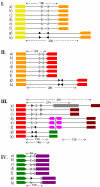Variations in gene organization and DNA uptake signal sequence in the folP region between commensal and pathogenic Neisseria species
- PMID: 16503987
- PMCID: PMC1431543
- DOI: 10.1186/1471-2180-6-11
Variations in gene organization and DNA uptake signal sequence in the folP region between commensal and pathogenic Neisseria species
Abstract
Background: Horizontal gene transfer is an important source of genetic variation among Neisseria species and has contributed to the spread of resistance to penicillin and sulfonamide drugs in the pathogen Neisseria meningitidis. Sulfonamide resistance in Neisseria meningitidis is mediated by altered chromosomal folP genes. At least some folP alleles conferring resistance have been horizontally acquired from other species, presumably from commensal Neisseriae. In this work, the DNA sequence surrounding folP in commensal Neisseria species was determined and compared to corresponding regions in pathogenic Neisseriae, in order to elucidate the potential for inter-species DNA transfer within this region.
Results: The upstream region of folP displayed differences in gene order between species, including an insertion of a complete Correia element in Neisseria lactamica and an inversion of a larger genomic segment in Neisseria sicca, Neisseria subflava and Neisseria mucosa. The latter species also had DNA uptake signal sequences (DUS) in this region that were one base different from the DUS in pathogenic Neisseriae. Another interesting finding was evidence of a horizontal transfer event from Neisseria lactamica or Neisseria cinerea that introduced a novel folP allele to the meningococcal population.
Conclusion: Genetic recombination events immediately upstream of folP and horizontal transfer have resulted in sequence differences in the folP region between the Neisseria species. This variability could be a consequence of the selective pressure on this region exerted by the use of sulfonamide drugs.
Figures



 : GCCGTTTGAA;
: GCCGTTTGAA;  : GCCGTCCGAA;
: GCCGTCCGAA;  : GCCGTATGAA;
: GCCGTATGAA;  : ACCGTCTGAA;
: ACCGTCTGAA;  : ATCGTCTGAA. Triangles pointing towards each other illustrate inverted repeats. For the complete nucleotide sequences, see Additional file.
: ATCGTCTGAA. Triangles pointing towards each other illustrate inverted repeats. For the complete nucleotide sequences, see Additional file.References
-
- Holmes EC, Urwin R, Maiden MC. The influence of recombination on the population structure and evolution of the human pathogen Neisseria meningitidis. Mol Biol Evol. 1999;16:741–749. - PubMed
-
- Feil EJ, Maiden MC, Achtman M, Spratt BG. The relative contributions of recombination and mutation to the divergence of clones of Neisseria meningitidis. Mol Biol Evol. 1999;16:1496–1502. - PubMed
-
- Bowler LD, Zhang QY, Riou JY, Spratt BG. Interspecies recombination between the penA genes of Neisseria meningitidis and commensal Neisseria species during the emergence of penicillin resistance in N. meningitidis: natural events and laboratory simulation. J Bacteriol. 1994;176:333–337. - PMC - PubMed
Publication types
MeSH terms
Substances
Associated data
- Actions
- Actions
- Actions
- Actions
- Actions
- Actions
- Actions
- Actions
- Actions
- Actions
- Actions
- Actions
- Actions
- Actions
- Actions
- Actions
- Actions
- Actions
- Actions
- Actions
- Actions
- Actions
- Actions
- Actions
- Actions
- Actions
- Actions
- Actions
- Actions
- Actions
- Actions
- Actions
- Actions
- Actions
- Actions
- Actions
- Actions
- Actions
- Actions
- Actions
- Actions
- Actions
- Actions
- Actions
- Actions
- Actions
- Actions
- Actions
- Actions
- Actions
- Actions
- Actions
- Actions
- Actions
LinkOut - more resources
Full Text Sources
Other Literature Sources

